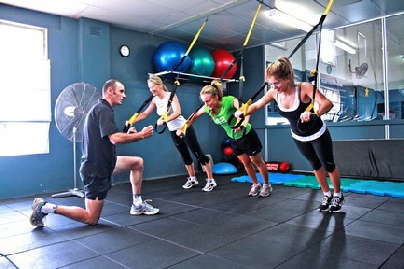
© Ennis Physiotherapy Clinic, 3A Barrack Close, Barrack Street, Ennis, Co. Clare V95 X437 Tel: (065) 6840757
Spinal Problems Neck + Back Pain Disc Injury Whiplash Posture
Lower Limb Injuries Walking + Running Ligament Injury Snowsports Injury Home Exs Prog
Upper Limb Injuries Ligament Sprains Tendon+Muscle Golf + Bike Set Up Useful Links

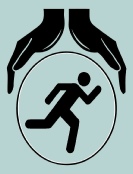


065 6840757

Mon - Fri 9.30am - 8.30pm


3a Barrack Close, Barrack St., Ennis, Co. Clare V95 X437
Training is the process of acquiring or adapting / improving / developing a skill or behaviour. It encompasses organised activity aimed at imparting information or instructions in order to;
1. improve a person’s performance or
2. achieve a greater level of skill or knowledge
In relation to physiotherapy, exercise or sports medicine, training means stimulating structural and functional adaptations to improve performance in specific physical tasks. Training programmes use a blend of the following elements to achieve focused results
- Type of training
- Frequency and length of workouts
- Intensity, speed and duration of exercise
- Repetition
- Rest / recovery
- Appropriate levels of competition - graded return to sport
A New Years’ Resolutions may be the first introduction to ‘training’ a person gets

Training
- Overload Principle; The muscles and the body’s systems (nerve, balance etc) must be repeatedly and increasingly overloaded in order to see an ongoing training effect. Initial improvements in strength measures may simply reflect more efficient muscle and nerve functioning rather than representing an absolute increase in strength. Certain individual physiological constraints (for instance a low VO2max – the maximum rate at which oxygen can be utilised by a person or having few fast twitch muscles fibres would not bode well for a high level sprinter) may limit the maximum performance achievable by an individual
- Specificity Principle; Training exercises to enhance the physiological, metabolic and psychological adaptations required to improve performance. Characteristics of strength, endurance, power, speed, fine control can all be trained specifically. “Specific exercises illicit specific adaptation to create specific training effects”.
- Individual Differences Principles; Many factors contribute to the training responses seen in each individual – initial strength and fitness level, motivation, fears, age, sex etc will all have an impact on training response to specific training exercises
- Reversibility Principle; A rapid loss of performance adaptation will occur if the person stops regular training in a specific action or skill – known as detraining. Exercise capacity will reduce within a couple of weeks and all improvements may be lost within a number of months of stopping training
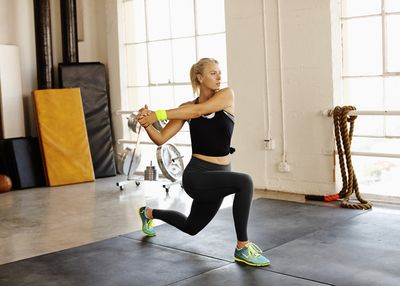
Principles of Training
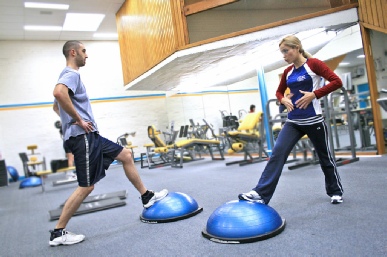
The most successful training programmes are carefully planned out and executed. They are
- creative and keep the person challenged but also interested, :
- specific to the goals of the person undertaking the training and can be adapted according to progress or new circumstances as they arise,
- realistic and achievable
- rewarding with improvements in performance of the activity being trained.
Goals for training can be adapted and changed as necessary as circumstances, or needs, demand.
Training usually will begin with general training and move increasingly toward more and more task specific training i.e. in sport people begin by improving general fitness levels first, then work on strength and endurance and finally start to direct that improved strength and endurance at specific work / sport specific tasks / skills.
Training programmes are
- Specific to the ultimate goal of the training – is it to run a marathon or a 5K event?, is it to get back to work?, is it to acquire a complex motor skill?
- Specific in the blend of strength, flexibility, endurance and power training for the achievement of the goals set.
- Specific in the frequency and duration of training sessions to achieve the required standard of performance of activity – to improve performance generally requires more intense and more frequent training than does the maintenance of a standard of performance.
- Creative in providing a variety of training opportunities to achieve the same end result – rowers will often use cross country skiing in the winter to maintain overall fitness, hurlers will often use rugby or soccer in the winter to maintain fitness for their sport in the off season, swimming is a weight free option for lower limb training.
- Adaptable to allow sufficient recovery between sessions - It is easy to reduce intensity or duration of a session if there has been inadequate recovery been session to allow for the adaptation that is sought i.e. muscle will increase in strength more quickly than scar tissue will and so progress may be expected to be slower initially following muscle injury while the scar ‘strengthens’ to be able withstand the forces generated by the muscle itself.
- Planned to maximise progression at a rate that is achievable and maintainable.
Typically training programmes are planned in blocks of time taking account of when the ultimate goals are required to be achieved. A fit trained runner needs less time to prepare themselves for a marathon than does a complete novice.
By benchmarking progress against set goals one can gauge progress and adjust training accordingly. One can also make informed decisions on return to play / work etc.
Very limited time scales may mean certain elements of training are sacrificed and others are prioritised.
Achieving goals in the training programme helps boost confidence + self belief and improves the likelihood of achieving the ultimate goals of the programme. Having goals also allows a critical objective review of progress to date and assessment of how achievable goals are within the given time.
Training Programme
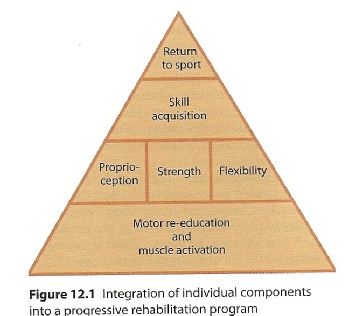
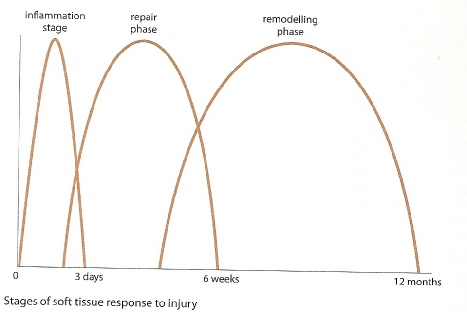
Rehabilitation (Rehab) is the process of training for recovery following an injury, in order to restore the person to their former functional capacity, or better.
The ultimate goal is to return to play, or function, in the shortest possible time or to achieve a standard of performance that is either equal to, or greater, than existed pre-injury.
The ‘art’ of guiding rehabilitation is in using scientific knowledge of tissue healing + recovery to create a rehabilitation programme which takes into account the needs + goals of the injured person, the type + severity of the injury, the social, psychological + physical environment that are prevailing for the injured person and the resources available to the person. It is the successful management of all these opportunities and constraints that will provide the best possible outcome from a rehab programme.
The lifestyle factors / demands on an individuals person, combined with their level of self confidence, motivation + fears must be considered when customising a programme for them. Each programme should be explained to the person (how + why it is planned to address the presenting problems and what input is required from the injured person + when) and an estimated timescale outlined.
Precise, clear guidance must be provided with appropriate monitoring and correction as necessary. Some of the art of rehabilitation is in exploiting scarce resources or using alternative resources to facilitate the exercise programme i.e. using a backpack with heavy household items to replace ‘gym’ weights for increased leg exercises.
Rehab can start immediately an injury occurs and may continue long after the person has returned to sport / normal daily life – with maintenance exercises!
Components of a Rehabilitation Programme may include;
- Muscle Activation, re-education and muscle timing /
‘patterning’
- Muscle strengthening / conditioning
- Muscle Endurance
- Soft tissue flexibility (muscle + joint)
- Neuromuscular Control - Balance, Proprioception
(joint sense), Co-ordination
- Functional Activities / Work + Sport Specific Drills
- Cardiovascular Fitness
- Psychological Fitness – fear reduction, motivation,
over zealousness, mental toughness
Pain
Pain should not be ignored but equally should not deter someone from completing their rehab programme.
While severe pain may negatively impact on the recruitment of muscles (we are not inclined to do things that give us pain generally!) some pain or discomfort may be considered a normal side effect of participation in a rehab programme.
Using the overload principle as a means of increasing tissue strength, and the stimulating effect on healing tissues provoked by increasing the activity load, the ability of exercised tissues to withstand stresses during activity will increase progressively. Therefore it is a matter of managing any pain or soreness which develops as a result of rehab exercises.
One would aim to keep pain and aching symptoms bearable – if too much pain is produced you need to adapt by reducing the overall exercise load and if little or no pain is felt after a rehab sessions then it is safe to progress the intensity / duration / resistance components at the next training session. In general it is best to increase only one component at a time and review the effects during and in the following hours after the session, to assess if further adaptation is possible..
Rehabilitation
